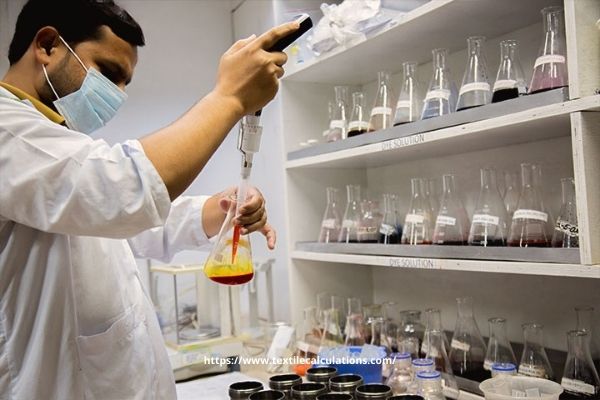Dyeing Calculation:
At the initial stage of dyeing calculation, one needs to calculate the dyeing recipe the lap deep before going for bulk productions. For this, a lot of work is done in the dyeing laboratory. In the dyeing lab, lab dip or sample is developed by the dyeing master. Lab dip plays an important role in shade matching & this is an important task before bulk production. This article just for beginners who are entering into dyeing production the dyeing calculation in lab dip will help them.

Sample recipe:
- Material weight = 5.0 gm
- Wetting agent = 0.5 g/l
- Sequestering agent = 2.0 g/l
- Antipilling agent = 1 g/k
- Dyes = 1.5%
- Glauber salt = 40 g/l
- Soda ash = 10 g/l
- M : L = 1 : 10
Stock Solution Concentration:
- Wetting agent, sequestering agent, and anti-pilling agent = 1.0%
- Dyes = 1.0%
- Salt, soda ash = 20%
Dyeing Calculation in Lab Dip
Dyeing Calculation:
1. Total amount of liquor = 5 X 10 = 50 ml
2. Required wetting agent = [{ Total liquor (lit) X Recipe amount in gm/l} / Stock solution%]
= [{(50 ml/1000 ml) X 0.5 g/l} / 1.0%]
= 2.5 ml
3. Required sequestering agent = [{ Total liquor (lit) X Recipe amount in gm/l} / Stock solution%]
= [{(50 ml/1000 ml) X 2 g/l} / 1.0%]
= 10 ml
4. Required antipilling agent = [{ Total liquor (lit) X Recipe amount in gm/l} / Stock solution%]
= [{(50 ml/1000 ml) X 1.0 g/l} / 1.0%]
= 5 ml
5. Required amount of glauber salt = [{ Total liquor (lit) X Recipe amount in gm/l} / Stock solution%]
= [{(50 ml/1000 ml) X 40 g/l} / 20%]
= 10 ml
6. Required amount of soda ash = [{ Total liquor (lit) X Recipe amount in gm/l} / Stock solution%]
= [{(50 ml/1000 ml) X 10 g/l} / 20%]
= 2.5 ml
7. Required Dye solution = [{Material weight X recipe amount % (or shade %)} / Stock solution%]
= {(5.0 gm X 1.5%) / 1.0%}
= 7.5 ml
8. Required amount of additional water = {50 – (2.5 + 10+5+7.5+10+2.5)} ml
= (50 – 37.5) ml
= 12.5 ml
Calculation of the dyeing recipe is done by the dyeing master. The whole work process is done in lap dip. Lab dip is a process by which buyers supplied swatch is matched with the percentage of the varying dye in the laboratory. Lab dip plays an important role in shade matching & and detaching the characteristics of the dyes and chemicals that are to be used in the large scale of production. So this is an important task before bulk production.

